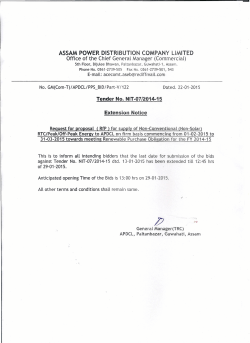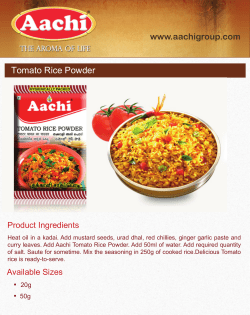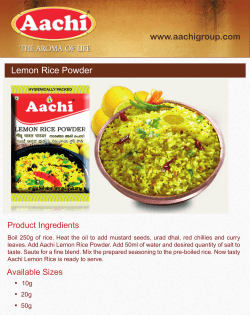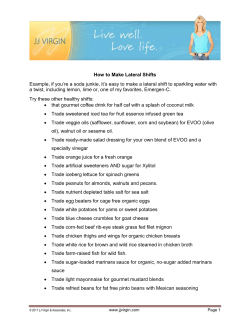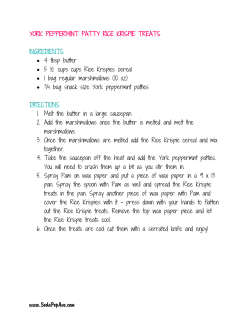
Joha Rice: An aromatic indigenous rice of Assam, India contains
Available online at www.scholarsresearchlibrary.com Scholars Research Library Der Pharmacia Lettre, 2015, 7 (1):212-217 (http://scholarsresearchlibrary.com/archive.html) ISSN 0975-5071 USA CODEN: DPLEB4 Joha Rice: An aromatic indigenous rice of Assam, India contains flavanoids and phenolic substances and shows good antioxidant activities Habibur Rahman*1,2, M. Chinna Eswaraiah1 and A. M. Dutta2 1 Anurag Pharmacy College, Kodad, Telengana State, India 2 Assam Down Town University, Guwahati, Assam, India _____________________________________________________________________________________________ ABSTRACT The objective of present work is to study the in-vitro anti-oxidant activities of Joha Rice; an aromatic indigenous rice of Assam, India. Anti-oxidant activity of the extracts were studied using 1,1-diphenyl-2-picryl hydrazyl (DPPH) radical scavenging activity, Hyderogen peroxide(H2O2) scavenging activity and Nitric Oxide(NO) scavenging activity. The total Phenolic contents and Flavanoid contents were estimated taking Gallic Acid and Quercetin calibration curve respectably. In in-vitro anti-oxidant studies it was found that ethanolic extract of Joha Rice posses good free radical scavenging activity and was comparable with standard Ascorbic acid. The IC 50 for Joha Rice was found in DPPH scavenging activity 81.45±2.29 µg/ml, Hydrogen Peroxide scavenging activity 121.30±2.20 µg/ml and Nitric Oxide scavenging activity 137.67±3.34. The total Phenolic content was found 74.86±2.474 mg/gm Eq of Gallic Acid and Total Flavanoid content was 190.7±15.28 mg/gm Eq of Quercetin. Ethanolic extract of Joha Rice contains phenolic and Flavanoids and posses anti-oxidant activities in In-vitro methods. So, we can further use this for screening of biological activities in metabolic and degenerative diseases which were cause due to free radical mechanism. Keywords: Joha Rice, aromatic Rice, Assam, 1,1-diphenyl-2-picryl hydrazyl (DPPH), Total Phenolic Content, Ascorbic acid, IC50 value. _____________________________________________________________________________________________ INTRODUCTION Assam is a land of thousands of natural herbs and medicinal plants. The unique geographical location, abundant of fertile soil, friendly climate and high rain fall make a gift of herbal resources. With its vast hills and forests, Assam is the home to a variety of medicinal plants such as word famous Tea (Camelia sinensis), Sarpagandha (Rauvolfia serpentine Benth.ex.Kur), Pippali (Piper longam Linn), Amlakhi (Emblica officinalis Gaertn), Hilikha (Terinalia chebula Retz.), Bhomora (Terminalia belerica) etc.. More than 300 medicinal plants have been identified in Assam but only about 5-10% of the plants and herbs are currently utilized [1] and the rest hold a vast potential. Lack of knowledge, space and adequate facilities are playing important hurdles to save the unique gift of nature in Assam for making scientifically evident medicinal drug in present market. Joha Rice is one of the 40000 varieties of species Oryza sativa and popular for its great aroma and equally remarkable taste. It is commonly used to prepare Khiir or Payash or Pulao like traditional recipe [2]. Some literature available which mentioned the anti-oxidant properties of rice. Laokuldilok T et al reported that several pigmented rice brans have free radical scavenging and antioxidant activity [3]. 212 Scholar Research Library Habibur Rahman et al Der Pharmacia Lettre, 2015, 7 (1):212-217 ______________________________________________________________________________ Muntana N and Prasong S reported total phenolic contents and their antioxidant activities of Thai white, red and black rice bran extracts [4]. Rao AS et al reported antioxidant and antiproliferative activities of methanolic extracts from Njavara rice bran [5]. But, there is no literature or studies conducted for Joha Rice of Assam for any anti-oxidant potential. Now a day, it is well peoples are concerned about Reactive Oxygen Species (ROS) and oxidative stress as they play crucial role in the development of degenerative diseases and pathogenesis of diabetes, cardiovascular diseases, nephrotoxicity, hepatotoxicity, neurological disorders, inflammations, cancer and in the process of aging [6-10]. It has been suggested that some natural plants, fruits and vegetables contain a large variety of substances like flavonoids, polyphenolic compounds, Vitamin C, Carotinoids, tannins etc. has antioxidant and free-radical scavenging activities[11-12]. The objective of present work is to study the in-vitro anti-oxidant activities of Joha Rice; an aromatic indigenous rice of Assam, India so as to make a route for researcher to study medicinal importance of Joha rice, like Tea. MATERIALS AND METHODS Chemicals and Instruments Ascorbic acid, quercetin, gallic acid, hydrogen peroxide, trichloroacetic acid, ferric chloride, folin-ciocalteu reagent, α-α diphenyl β picryl hydrazyl (DPPH), Griess reagent, were all purchased from SD-fine chemicals, India, all other reagents used were of analytical grade. Instruments UV/VIS Spectrophotometer (LABINDIA, UV 3000+), Microcentrifuge ( REMI, RM-12 C) Plant material and extraction procedures: Oryza sativa (var. Joha Rice) was collected from local cultivators of Assam and was authenticated by Prof. Dr. K. Madhava Chetty, Taxonomist, SVU University, Chithoor, Andhra Pradesh (India). Joha Rice was subjected to size reduction to a coarse powder by using dry grinder and passed through sieve. This powder was packed into soxhelet apparatus and extracted successively with ethanol. Preliminary Phytochemical Analysis The ethanolic extract of Joha Rice was subjected to preliminary phytochemical screening using standard methods [13]. In-vitro Anti-oxidant activity DPPH radical scavenging activity The ability of the plant extract to scavenge 1,1-diphenyl-2-picryhydrazyl (DPPH) free radicals was assessed by the standard method [14]. The stock solution of extract was prepared in ethanol to achieve the concentration of 1 mg/ml. Dilutions were made to obtain concentrations of , 25, 50, 100, 250, 500 µg/ml. Diluted solutions (1 ml each) were mixed with 3 ml of ethanolic solution of DPPH (DPPH, 0.004%). After 30 min of incubation at room temperature the reduction of the DPPH free radical was measured by reading the absorbance at 517nm using UV-Visible Spectrophotometer. Initially, absorption of blank sample containing the same amount of ethanol and DPPH solution was prepared and measured as control. Ascorbic acid was used as standard. The experiment was carried out in triplicate. Percentage inhibition was calculated using equation (1), while IC50 values were estimated from the % inhibition versus concentration plot, using a non-linear regression algorithm. The data were presented as mean values ± standard deviation (n = 3). (Absorbance of control- absorbance of sample) % inhibition= ------------------------------------------------------------X 100 Absorbance of control equation----- (1) Hydrogen peroxide scavenging activity Scavenging activity of Hydrogen peroxide (H2O2) by the plant extract was determined by the method [15]. Plant extract (4 ml) prepared in distilled water at various concentration(25, 50, 100, 250, 500 µg/ml) was mixed with 0.6 ml of 4 mM H2O2 solution prepared in phosphate buffer (0.1 M pH 7.4) and incubated for 10 min. The absorbance of the solution was taken at 230 nm. Ascorbic acid was used as a positive control compound. The percentage of inhibition was calculated by comparing the absorbance values of the control and test samples using Eq. (1). IC50 values were estimated from the % inhibition versus concentration plot, using a non-linear regression algorithm. 213 Scholar Research Library Habibur Rahman et al Der Pharmacia Lettre, 2015, 7 (1):212-217 ______________________________________________________________________________ Nitric oxide scavenging activity Nitric oxide radical scavenging activity was determined according to the method [16]. 2 ml of 10 mM sodium nitroprusside in 0.5 ml phosphate buffer saline (pH 7.4) was mixed with 0.5 ml of extract at various concentrations prepared in ethanol and the mixture incubated at 25oC for 30 min. Thereafter, 1.5ml of Griess reagent (1% sulphanilamide, 0.1% naphthylethylenediamine dichloride and 3% phosphoric acid) was added to each test tube. The absorbance was measured, immediately, at 546 nm and percentage of scavenging activity was measured with reference to ascorbic acid as standard. The nitric oxide radicals scavenging activity was calculated. The percentage inhibition of nitric oxide generated was measured by comparing the absorbance values of control and test samples using Eq. (1). IC50 values were estimated from the % inhibition versus concentration plot, using a non-linear regression algorithm. Estimation of total phenolic content Total phenolic content (TPC) were determined using Folin-Ciocalteu reagent [17]. Briefly, an aliquot of the sample extract (0.1 ml of 1000 µg/ml in ethanol) was mixed with distilled water (3 ml) and 0.5 ml of Folin-Ciocalteu reagent was added. After 3 min, 2 ml of 20% sodium carbonate was added and mixed thoroughly. The tubes were incubated in a boiling water bath for exactly 1 min, then cooled and the absorbance was measured at 650 nm using against the reagent blank. The calibration curve was prepared by gallic acid solution (0 - 100µg/ml) in ethanol. TPC was expressed as mg gallic acid equivalent (GAE)/100 g sample dry weight. Total flavonoids determination Aluminum chloride colorimetric method was used to determine Total Flavonoids contents in extracts [18-19]. Briefly, an aliquot of 0.5 ml of 2% AlCl3 was added to 0.5 ml of sample solution. After 1 h at room temperature, the absorbance was measured at 420 nm at the final concentration of 1000 µ/ml). TFC was calculated as mg quercetin equivalent (QE) /100 g sample dry weight. The calibration curve was prepared by quercetin solution (0 - 100µg/ml) in ethanol. RESULTS The Joha rice was extracted with ethanol and an oily semisolid brownish black colour extract was found. The percentage yield was 3.6 % (w/w). The ethanolic extract of Joha rice was found to contain different phytoconsituents like proteins, terpinoids, phenolic compounds, flavanoids, carbohydrates and volatile oils. In-vitro Antioxidant Activities In-vitro antii-oxidant activity of ethanolic extract of Joha rice (EEJR) was done by using (DPPH) radical scavenging activity, Hyderogen peroxide(H2O2) scavenging activity and Nitric Oxide(NO) scavenging and results are shown in Table-1. The ethanolic extract of Joha rice (EEJR) at various concentration (25- 500 µg/ml) were prepared of as well as standard Ascorbic acid (5 -50 µg/ml). The percentage inhibition (% inhibition) at various concentration (50- 500 µg/ml) of EEJR and Ascorbic acid (55 -50 µg/ml) were calculated and IC50 values were obtained graph by linear regression analysis. Table-1: Antioxidant Activity of Ethanolic Extract of Joha Rice (EEJR) in using free radical Scavenging methods IC50 ((µg/ml) Concentration (µg/ml) DDPH Nitric Oxide Hydrogen peroxide EEJR (25-500) 81.45±2.29 137.67±3.34 121.30±2.20 Ascorbic Acid (5-50) 39.42±1.29 46.69±2.40 43.23±2.21 All values are in mean ± standard deviation (sd) (where, n=3).; IC50= Inhibitory Concentration 50. EEJR= Ethanolic Extract of Joha Rice; DDPH=1,1-diphenyl-2-picryhydrazyl Total Phenolic contents The Total phenolic content of ethanolic extract of Joha Rice was estimated using standard Gallic acid equivalent of phenols. The various concentration of Gallic acid (10-200 µg/ml) calibration curve was plotted using Microsoft Office Excel 2007 and standard calibration cureve is plotted (Fig-1). The total phenolic content EEJR was obtained for 1000 µg/ml of extract from Total Phenolic content calibration of gallic acid (y=0.007x+ 0.056, R2=0.995) and found 74.86±2.474 mg/g equivalent of Gallic acid (Table-2). 214 Scholar Research Library Habibur Rahman et al Der Pharmacia Lettre, 2015, 7 (1):212-217 ______________________________________________________________________________ Fig-1: Standard Calibration curve for Total Phenolic contents for standard Gallic Acid Table-2: Total Phenolic contents of oryza sativa (var. Joha Rice) extract Concentration 1000(ug/ml) Absorbance Total Phenolic Content (mg/g GAE) 1 2 3 0.56 0.59 0.59 74.86±2.474 Values are in Mean ±SD for three readings Results for Total Flavanoid content The Total flavanoid of Ethanol extract of Joha Rice was estimated using standard Quercetin. The various concentration of Quercetin (25-100 µg/ml) and calibration curve was plotted using Microsoft Office Excel 2007 (Fig-2). The Total flavanoid content for the extract was determined by using standard calibration curve (y=0.001x+ 0.057, R2=0.998) and found to have 190.7±15.28 mg/g equivalent of Quercetin respectably (Table-3). Fig-3: Stnadard Calibration curve for Total flavanoid contents for standard Quercetin 215 Scholar Research Library Habibur Rahman et al Der Pharmacia Lettre, 2015, 7 (1):212-217 ______________________________________________________________________________ Table-3:Total Flavanoid contents of oryza sativa (var. Joha Rice) extract Concentration 1000(µg/ml) Absorbance Total Flavanoids Content (mg/g ) 1 2 3 0.23 0.25 0.26 190.7±15.28 Values are in Mean ±SD for three readings DISCUSSION The Ethanolic extract of Joha Rice (EEJR) tested for phytoconstitutents like reducing sugars, phenolic compounds, flavanoids, protein, carbohydrates and volatile oils. The Knowledge of the chemical constituents of plants is helps to screen for biological activities [20]. The phenolic and flavanoids are widely distributed secondary metabolites in plants having anti-oxidant activity and have wide range of biological activities as anti-apoptosis, anti-aging, anticarcinogen, anti-inflammation, anti-atherosclerosis, cardiovascular protection and improvement of endothelial function, as well as inhibition of angiogenesis and cell proliferation activities [21-22]. Recent studies have shown that many dietary polyphenolic constituents derived from plants are more effective antioxidants In-vitro than vitamins E or C, and thus might contribute significantly to the protective effects in-vivo [23]. In-vitro antioxidant studies are widely carried to screen various plant containing phenolic and flavanoids constituents. Plant derived antioxidant compounds, flavonoids and phenolics have received considerable attention because of their physiological effect like antioxidant, anti-inflammatory, antitumor activities and low toxicity compared with those of synthetic phenolics antioxidant such as BHA (Butylated Hydroxyanisole), BHT (Butylated Hydroxytoluene) and Propyl Gallate(PG) [24-25]. In this present study, Ethanolic extract of Joha Rice Posses good free radical scavenging activities in DPPH, Nictric oxide and Hydrogen peroxide scavenging methods. The extract was found to contain phenolic and flavoinds. This is one of the main reason for possessing antioxidant activity. As previously, it was reported that Polyphenolic compounds contribute significantly to the total antioxidant capacity of plants [26]. Flavonoids play some important pharmacological roles against diseases, such as cardiovascular disease, cancer, inflammation and allergy. Epidemiological studies have indicated the relationship between flavonoid intake and reduced risk of certain cancers[27]. CONCLUSION Finally, it can be concluded that Joha rice-an indigenous aromatic rice of Assam posses good anti-oxidant activities by further extensive research, we can explore its medicinal value. REFERENCES [1] Industries and Minerals of Assam. 2014, Retrieved from http://online.assam.gov.in/web/guest/industriesandminerals [2] Das, A., Tushar., Kesari, V., & Rangan, L , Agricultural Reviews, 2010, 31(1), 1-10 [3] Laokuldilok ,T., Shoemaker, C.F., Jongkaewwattana, S. & Tulyathan, V, J Agric Food Chem, 2011, 59(1),193199. [4] Muntana, N., & Prasong, S, Pak J Biol Sci, 2010, 13(4), 170-174. [5] Rao, A.S., Reddy, S.G., Babu, P.P. & Reddy, A.R, BMC Complement Altern Med, 2010, 10:4. [6] Florence, T. M, Australian and New Zealand journal of ophthalmology, 1995, 23(1), 3-7. [7] Bokov, A., Chaudhuri, A., & Richardson, A, Mechanisms of ageing and development, 2004, 125(10), 811-826. [8] Uttara, B., Singh, A. V., Zamboni, P., & Mahajan, R. T, Current neuropharmacology, 2009, 7(1), 65-74. [9] Dhalla, N. S., Temsah, R. M., & Netticadan, T, Journal of hypertension, 2000, 18(6), 655-673. [10] Valko, M., Leibfritz, D., Moncol, J., Cronin, M. T., Mazur, M., & Telser, J, The international journal of biochemistry & cell biology, 2007, 39(1), 44-84. [11] Pietta, P. G, J. Nat. Prod, 2000, 63 (3):1035–1042. [12] Zheng, W., & Wang, S. Y., Journal of Agricultural and Food chemistry, 2001, 49(11), 5165-5170. [13] Kokate, C.K, Practical Pharmacognosy, 5th Edition, Vallabh Prakasham, 1991, p.107-121. [14] Hirano, R., Sasamoto, W., Matsumoto, A., Itakura, H., Igarashi, O., & Kondo, K, Journal of nutritional science and vitaminology, 2001, 47(5), 357-362. [15] Yin, J., Heo, S. I., & Wang, M. H, Nutrition research and practice, 2008, 2(4), 247-251. 216 Scholar Research Library Habibur Rahman et al Der Pharmacia Lettre, 2015, 7 (1):212-217 ______________________________________________________________________________ [16] Zhao, J., Liu, T., Ma, L., Yan, M., Gu, Z., Huang, Y., & Zhao, Y, Evidence-Based Complementary and Alternative Medicine, 2011, 49, 73-76. [17] Islam, E., Islam, R., Rahman, A. A., Alam, A. K., Khondkar, P., Rashid, M., & Parvin, S, BMC research notes, 2013, 6(1), 121. [18] Khan, R. A., Khan, M. R., Sahreen, S., & Ahmed, M, Chem Central J, 2012, 6(1), 43. [19] Sulaiman, C.T. &Balachandran, I, Indian J Pharm Sci, 2012, 74(3), 258–260. [20] Mojab, F., Kamalinejad, M., Ghaderi, N. & Vanidipour, H.R, Iran J. Pharm. Res, 2003, 3, 77-82. [21] Catherine, A., Rice-Evans., Nicholas, J. & Miller, G.P, Free Radical Biology and Medicine, 1996, 20(7), 933– 956. [22] Wolf, B. & Manfred, S, Free Radical Research, 1987, 2(4-6), 289-294. [23] Kumar, S.D. & Kumar, O.P, EJEAF Chem, 2008, 7, 2863-2871. [24] Sharififar, F.G., Dehghan, N. & Mirtajaldini, M, Food Chem, 2009, 112, 885-888. [25] Chidambaramurthy, K.N., Vanitha, A., Mahadevaswamy, M. & Ravishankar, G.A, (Journal of Medicinal Food , 2003, 6(2), 99-105. [26] Maity, S., Chatterjee, S., Variyar, P.S., Sharma, A., Adhikari, S. & Mazumder, S, J Agric Food Chem, 2013, 61(14), 3443-3450. [27] Habbu, P.V., Mahadevan, K.M., Kulkarni, P.V., Daulatsingh, C., Veerapur, V.P. & Shastry, R.A, Indian J Exp Biol ,2010, 48(1), 53-60. 217 Scholar Research Library
© Copyright 2025



